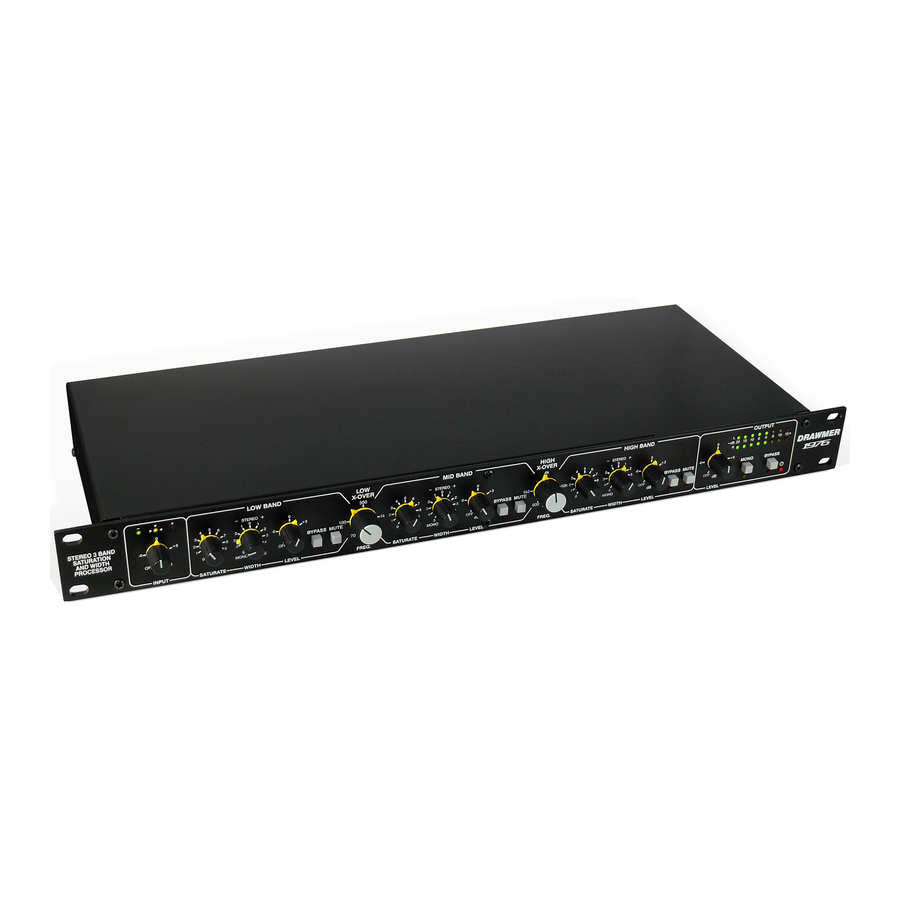Drawmer 1976 Руководство по эксплуатации - Страница 10
Просмотреть онлайн или скачать pdf Руководство по эксплуатации для Компьютерное оборудование Drawmer 1976. Drawmer 1976 13 страниц. Stereo 3 band saturation and width processor

Basslines
If your bassline sounds a little flat and lifeless it will really benefit from a adding some saturation. This will bring out the grit,
dirty the sound and fatten it out. And we're not just talking about bass guitar here, use it on sine generated basslines to
make them sound more natural, and push them out into the mix.
Experiment here, and drive the saturation hard to see if the heavily distorted sound appeals.
Synths
Synths tend to sound too digital and clinical. Saturation will bring them to life, making them sound warmer, more natural,
and closer to the analogue sound that they emulate. It'll inject harmonics and grit, and make the synths stand out more in
the mix. With synths saturation should be used fairly subtly - add saturation until its noticeable and then back it off a little.
Vocals
Saturation is one of the secrets to great sounding vocals. Your vocal recordings may sound good but saturation will make
them sing (pun intended). It will make any vocal sound fuller, especially thin and dull voices, and will warm and tame harsh
sounding vocals by subtly softening sibilance. Don't go over the top though, keep the harmonic distortion gentle or it could
ruin the vocals all together.
Mix
For all of it's pros, digital recording has a major drawback, by it's very nature it sounds too, well, digital. It's too harsh, too
clean. Saturation can be the key here. It will add harmonic distortion to inject life and warmth into the mix, and help your
digital mixes sound more like those from the analogue recording era.
Just passing the audio through an analogue device will have some effect on warming the mix, though passing it through
the 1976 will take your mixes to the next level. Subtle saturation is the key here. Don't add too much distortion, it can quickly
ruin a mix if too harsh. Turn up the saturation controls until you can here it making a difference and then back it off a little.
Things Don't Stack Up
Of course it's perfectly correct to use saturation on multiple individual instruments and tracks throughout the mix but care
should be taken. The tracks sound fine by themselves but there is a risk of adding too much saturation to the mix if it's stacked
and stacked on one track after another. Too much saturation will cause your mix to over distort, soften the transients and make
your mix sound mushy as well as attenuating the signal to some extent. W henever adding saturation to individual tracks
always test it as part of the entire mix also to limit this occurring.
Wide Open
As a general rule use the Mid and High frequencies to provide the space and depth to the mix and keep the Lows mono, using
the W idth controls on the 1976 to taste.
It is essential that you check any widened stereo signal for mono compatibility, as the stereo image may drop significantly in
level, thin out, or even disappear altogether when monogised into one, due to phase cancellation. It's good practice to
maintain some central image, especially in the mid tones. In addition, using pan controls it's easy to move the image around,
however, try to maintain the stereo image so that it sits right in front of you on the whole rather than off centre. It can be very
disconcerting for the listener.
Ensure that the low frequencies (i.e. anything below 100Hz) are mono, by setting the 1976 low frequency width control counter-
clockwise. This includes bass drums, bass guitar, percussion etc. This is essential if you're mixing for vinyl, as a stereo bass
will result in the needle skipping. Don't worry too much about how this will effect the stereo image as the ears are poor at
judging direction in low frequencies anyway - this is why Sub & LFE speakers can be placed almost anywhere.
You can use the Mono switch on the 1976 to see how the stereo signal has been affected.
Monogising
Check your mix in mono - often! Just because a mix sounds good in stereo doesn't mean it will sound good when the left and
right channels are combined. Why should you care if your mix sounds good in mono? Well, most live music venues and dance
club sound systems are mono - running the PA or sound system in mono is common practice to ensure music sounds good
everywhere in the room because it removes the 'sweet spot' and the complex phase issues of stereo. In many cases the low
frequencies will be put through a crossover and summed to mono before being sent to the sub, such as in a home theatre
system, for example. Monogising is also necessary when testing the audio for use on nonstandard applications such as for
broadcast or mobile phone.
Monogising will highlight phase problems. When a stereo mix is combined into mono any elements that are out of phase will
drop in level or may even disappear completely. This could be because the left and right outputs are wired out of phase but it's
more likely to be due to phase cancellation caused by stereo widening effects and techniques, such as chorus.
Listening in mono also highlights problems with the stereo width and balance of the mix and is more apparent when you use
a lot of stereo-widening or width-enhancing techniques and tools. Switching mono in and out fairly q uickly may make it
apparent that the centre of the mix is shifting to the left or right, something that may go unnoticed if only working in stereo.
10
DRAWMER 1976 O
PERATOR'S
M
L
ANUA
